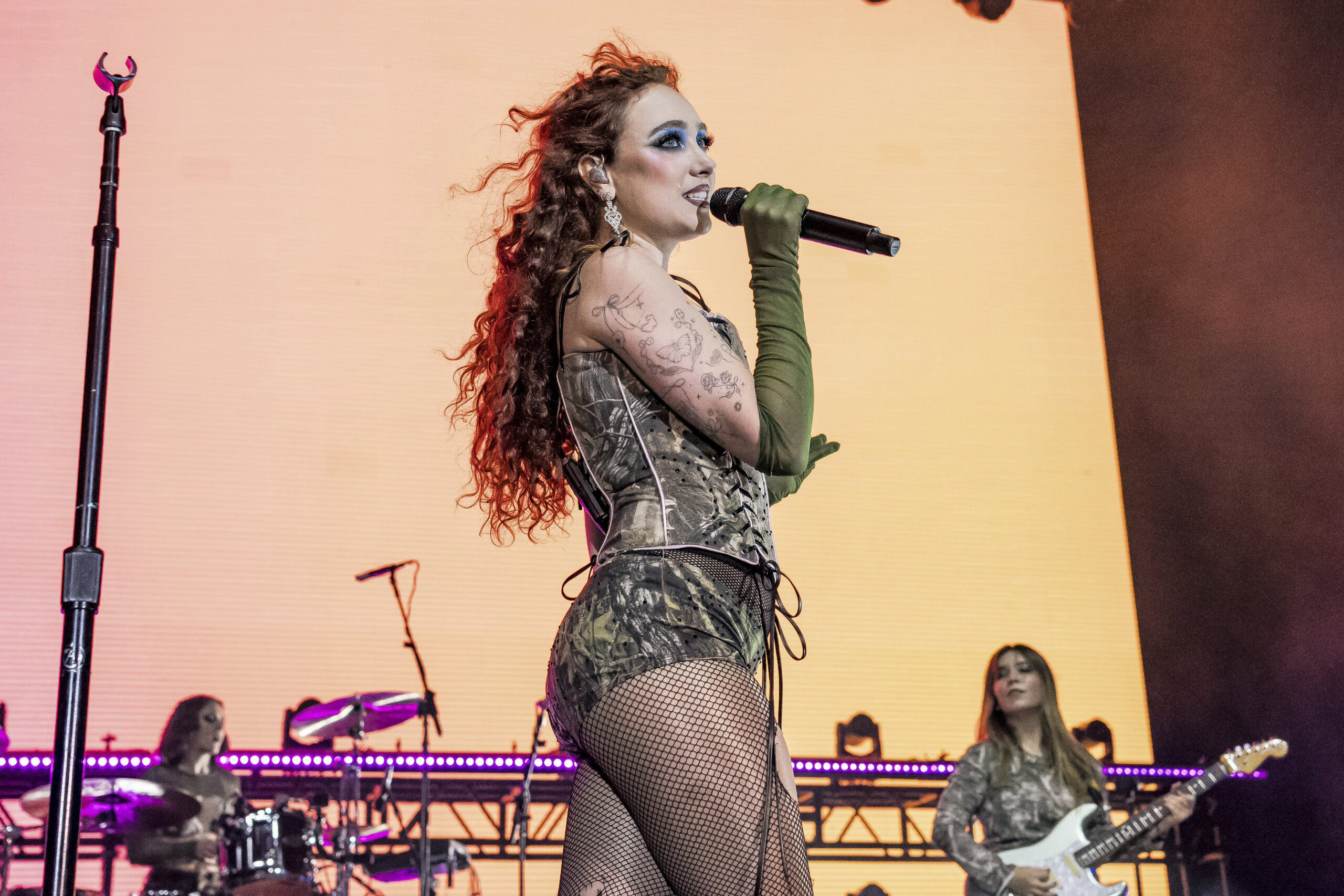The online discourse around Chappell Roan in recent weeks has been, frankly, appalling. From demands around her endorsing someone for the upcoming U.S. presidential election, to the response to her boundary-setting around toxic fans, to accusations that Saturday Night Live’s Bowen Yang was making fun of her in a sketch comparing the internet’s parasocial relationship with her to that of Thai superstar baby hippo Moo Deng, the vibes are bad.
And it’s really caused me to reflect on a question that’s popped up repeatedly in conversation with friends when talking about her meteoric rise over the past few months: What if Chappell Roan had simply stayed “gay famous,” rather than becoming a massive mainstream star? Wouldn’t that just be better for all of us and for her?
That’s not to disparage any of Roan’s success over the past year. I love that one of the most famous pop stars in the world is a queer woman who sings about getting eaten out in the passenger seat. That rules! But it is worth considering that her star has risen at such an exponential rate, both her and her fans are having a challenging time keeping up. The Rise and Fall of a Midwest Princess literally only came out a year ago. This time last year, gays in the know were bragging about having heard “Pink Pony Club” at an afterparty. In Vancouver, where I live, Roan played a sold-out November show at a 500-person venue.
Less than a year later, she was playing to somewhere close to 100,000 people at Lollapalooza. None of us could’ve predicted that level rise. Obviously there’s the rocket up the charts. The NPR Tiny Desk performance. Coachella. Lollapalooza. Cancelled European tour dates in order to perform at the VMAs. And with all of those successes have come millions of fans clamouring for more, watching her every move, stopping her on the street and worshipping her as their new gay pop idol—a pink country Taylor Swift, Lady Gaga and lesbian girl next door all rolled into one.
Things came to a head in recent weeks, as Roan called out fans for their toxic behaviour and harassment. Then she was heavily pressured by fans to issue an endorsement in the upcoming U.S. presidential election. That pressure led to a series of TikTok videos from Roan breaking down her personal politics without fully endorsing Kamala Harris, which subsequently led to more backlash and strain on Roan, ultimately culminating in her cancelling her much-hyped appearance at this past weekend’s All Things Go Music Festival to “prioritize [her] health.”
But none of this would be happening if Roan hadn’t shot up in the popular consciousness to the level she did this spring. If she’d stayed the cool, gay, niche figure she was a year ago, no one would care who she endorses or if she endorses at all. She could muse on TikTok all she wanted without every post turning into a dozen SEO-farmed articles.
The recent treatment of Roan, alongside other pop girlies of the moment, really has made the cultural case that being “gay famous” might ultimately be a lot better than being actually famous.
What do I mean by “gay famous”? It’s simple: famous with the gays, but not really a lot of other people. Reliable internet resource Urban Dictionary defines someone “gay famous” as “a person who is a celebrity but is only known as ‘that guy/girl’ outside of the Gay and Lesbian Community.” Last year, Saturday Night Live did a sketch featuring Troye Sivan (played there by Timothée Chalamet) as a sleep-paralysis demon. When the afflicted woman (Sarah Sherman) asks her doctor (Bowen Yang) if the figure she’s seeing is famous, Yang says “He’s gay famous! It’s different!”
And it certainly is. DJ Louie of the Pop Pantheon podcast pushes a similar tier of pop star who never broke mainstream but have a cult following: “niche legend,” comprising the likes of Robyn, the Scissor Sisters, Carly Rae Jepsen and a pre-“Brat summer” Charli XCX. Other “gay famous” artists include Sivan, Slayyyter, VINCINT, Betty Who—think Pride festival lineup, or West Hollywood SoulCycle playlist.
When I went on Pop Pantheon in early June to talk about Roan in the midst of her ascension, I made the case for her staying as a “gay famous” or “niche legend” as a best-case scenario. And I used the example of Jepsen specifically as the model of a working pop star who’s just famous enough to be successful and have a legion of devoted fans, but without any of the baggage that comes from true mainstream success.
Jepsen is the archetypal example of a pop star whose fame within the LGBTQ2S+ (though, let’s be real, mostly cis gay) population compared with the rest of the world is dramatically different. Ask most gay millennial men to name an iconic pop album, and Jepsen’s 2015 opus E•MO•TION will certainly come up. A decade later and you’ll still find it blasted on repeat throughout drag bars, Pride parties and my gym playlist. But despite widespread critical praise and that legion of gays eating it up, the album underperformed on the charts. So did its similarly beloved follow-up, Dedicated, and her subsequent releases. A good portion of the population likely still thinks of Jepsen as the “Call Me Maybe” girl, rather than an artist who’s put out banger after banger for years.
And she has kept putting out bangers, dropping basically an album every year or two for the past decade to the delight of her devoted fans. Sure, every now and then a piece of her music breaks through into bigger pop culture—take this clip from the title track off of her 2022 album The Loneliest Time, which had a moment on TikTok. But for the most part, she’s stayed in the margins. Her concerts aren’t rabid mobs where people get trampled.
In fact, ahead of a Jepsen show at a modestly sized hockey arena in Vancouver two years ago, my friends and I went for dinner at a bar across from the venue on the University of British Columbia campus. Halfway through our meal, our server pulled me aside and quietly pointed across the dining room, saying “she’s over there” (I was wearing a Carly Rae hat). And sure enough, I spotted the back of a head of blonde curls in the private side room of the pub, assumedly fuelling up ahead of her show.
Just imagine the fervour and the insanity if Roan was spotted in a restaurant across the street from her show. Or imagine if she went to New Orleans for a sister’s bachelorette, or to a nice hotel in Tofino for a family vacation, or got engaged to a bland-looking producer man whom the world doesn’t know all that much about—all things CRJ has done in recent years to minimal fuss. And all the while she’s been in the studio, making stuff for her fans and living a pretty normal life.
Being a massive mainstream pop star in 2024 comes with its own set of rules and boundaries. Look at the biggest names—Taylor Swift, Beyoncé, Rihanna, Olivia Rodrigo, Billie Eilish and even this summer’s breakout industry veterans Sabrina Carpenter and Charli XCX—what do they have in common? A pretty regimented PR machine and a controlled public image. Structure. Hard boundaries. And an air of mystery about them. Not giving too much of themselves to fans.
That’s not to suggest Roan isn’t capable of handling her meteoric fame, or that her emotional response in recent weeks is some sort of personal failing. But her music, persona and general vibe are one of the queer margins and your local gay bar. She has local drag queens open for her. She’s your favourite artist’s favourite artist. And she’s almost painfully earnest and direct with fans, as evidenced by those confessional TikTok videos.
All of that works if you’re Carly Rae Jepsen levels of famous. But as soon as you hit that upper echelon, the rules of the game change. You’ve got to lock things down, stop posting and build those firewalls—for the sake of the music, the fans and yourself. Roan’s repeated doubling down on the endorsement thing—rather than simply logging off and not posting—doesn’t work when you’re that famous. You’ll never be able to please everyone. You’ll always be a part of discourse.
Roan herself has had very little control in this whole situation. She didn’t necessarily ask to have the past year she’s had, and things have obviously spiralled past her and her team’s control or expectations (I mean look at those crowd sizes!). And for someone who just a few years ago was waiting tables, mainstream success on this scale probably felt like a distant aspiration.
But the vitriol with which the internet has responded to her every move, and how it’s ultimately affecting her music and her career, should cause all of us to pause for reflection on how we treat female pop stars in the spotlight, and what we expect of the uber famous. Obviously the toxic fans are to blame for a lot of this, but at the core of so many of their demands of Roan is that she be accessible to them—something her new level of fame will never afford them.
But the “gay famous”? They’ll always be at that perfect level. Personally, I’ll be wistfully dreaming of the lost possibility of a “gay famous” Chappell Roan, where she stayed just for us, playing venues we can afford tickets to, and she can get dinner outside of and intimate enough to hand her a giant foam sword (or, I don’t know, a glass of red wine).
Ultimately, that might’ve been better for everyone.


 Why you can trust Xtra
Why you can trust Xtra


